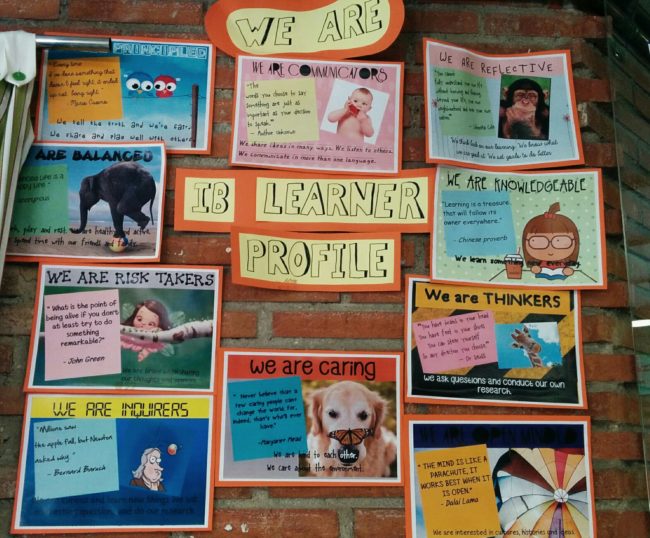Guidelines and help how to set up a PYP classroom.

I remember when I first started working in a PYP candidate school how clueless most of us (teachers) were about how to start the whole process, set up, planning, classroom and methodology. I eagerly searched for blog posts and articles mentioning PYP in practice. I’ve come a long way and step by step getting there although far from the perfect classroom. Well, I guess we are all still learning.
One of the most important pillars of the PYP is constant inquiry. So my journey to set up the PYP classroom started with some questions.
Have you thought about yours? What are your questions about classroom set up? Write them down so you’ll know where to begin and what you are looking for.
I had different sets of questions about the PYP classroom They were the following:
- How does a PYP classroom look like?
- What can we see walking in?
- What can we see on the walls?
- How do working stations set up?
- What are kids doing?
- How do they work? Individually? In pairs? In groups?
- What is the role of the teacher?
- How does it feel like?
- What do you feel when you walk into a classroom?
- Is it a happy environment?
- Does it support inquiry? How?
- Are kids busy with working? Do they use their time wisely? Chatting or sharing their ideas about valuable information?
- How can we (teachers) make sure that students are actually working?
- How does it sound like? Is it noisy? Is it quiet?
- Is it a nice working noise or is it loud and distracting?
- How can we handle noise level?
To answer these questions first we need to look around in our classroom. Is it inviting enough to come and work in for a whole school day or in fact school year? It is a very important question, as you and the students spend half of your life in that classroom. It’s better to make it feel like home. So if your answer is yes, you are on the right track.
However, if your answer is not, it leads to another question. How can you change it? I usually let my kids help me with classroom set up. The majority of the time we work in groups so the desks are arranged to do group work easily, to make communication comfortable but also everybody is able to see the board whenever it is needed to be seen.
We also have a reading nook with cushions where kids can go with their books and read comfortably. I bought some cheap cushions in IKEA and this little change and investment makes a big difference.
We also have kids work on the walls as “decorations” which we worked on that unit. Talking about the walls… most of the things on the walls are students created but we have our PYP “MUST HAVE-s” also on display somewhere in the class.
Essential Agreement

Which are basically our classroom rules created together and signed by every member of our classroom.
Transdisciplinary Themes
All six transdisciplinary themes with their descriptors (Who we are, Where we are in place and time, How the world works, Sharing the planet, How we organise ourselves, How we express ourselves) displayed in the classroom. I put them in order so kids always know where we are at the moment and what is going to be the next unit.
The eight key concepts and the corresponding key concept questions
Such as: Form, function, connection, causation, change, perspective, responsibility, reflection. We also have a short description of each key concept for students to understand it easier. (Three key concepts have to be displayed in the main board whichever ones are corresponding to the current unit.)
The IB Learner Profile

that we discuss first at the beginning of the year and every time when we finish a unit. Each student has to evaluate their improvement on the learner profile by putting each one of them on a scale and comparing them with their previous ones.
Attitudes
We also have a discussion about them at the beginning of the year and to start each unit students choose which ones they are going to focus more in the unit. Kids reflect on it at the end of the unit how successfully they could use these attitudes and whether they need to improve more.
Transdisciplinary Skills

Self-management skills (Gross motor skills, Fine motor skills, Spatial awareness, Organisation, Time management, Safety, Healthy lifestyle, Codes of behaviour, Informed choices)
Thinking skills (Acquisition of knowledge, Comprehension, Application, Analysis, Synthesis, Evaluation, Dialectical thought, Metacognition)
Communication Skills (Listening, Speaking, Reading, Writing, Non-verbal communication)
Social Skills (Accepting responsibility, Respecting others, Cooperating, Resolving conflicts, Group decision making, Adopting a variety of group roles)
Research skills (Formulating questions, Observing, Planning, Collecting data, Recording data, Organising data, Interpreting data, Presenting research findings)
Central Idea

which is always connected with the current unit.
Lines of inquiry

which are connected with the three key concepts of the current unit.
The inquiry cycle

You can find all sort of inquiry cycles on the Internet. I reckon you’ll choose the one best fit to your class or the subject you teach. Or you can make up your own one just like I did. My one is rather an inquiry road. It starts with provocation or tuning into the unit, researching, reflecting on found information and taking action.
These are the must have things, everything else is optional. Which leads us to the next question. Decoration or not decoration? Well, my classroom is changed all the time as an organic part of the unit of inquiry. It doesn’t mean teachers need to think of creating new displays over and over again. Classroom “decoration” is mostly visible thinking, like the Y-chart (I see, I think, I wonder), KWL chart or other similar things showing students questions, interest, researches and understanding on the topic.

We normally refresh and give a new look to our classroom at the beginning of a new unit as classroom environment reflects on what kids are inquiring on and help to understand the unit.
I usually start with an almost empty classroom, and let students’ creativity into motion. My part is to place some thought provoking pictures, keywords or sentences related to the new unit of inquiry in different parts of the classroom. Then as we work on the unit, more and more evidence appears on the walls. These evidences are all students’ work, thoughts, researches or resources they brought in such as books, articles, photos, or any material connected to our inquiry…
Our classroom has got some material that our school provides or school library lends us to support inquiry, students also volunteer to bring in things, books, interesting articles, magazines they find, related to our current unit. Obviously as soon as we finish a unit we take books back to the library and students take their belongings back home.
I hope these couple of things will help you getting started. If you have questions, photos or ideas about PYP classroom set up to share let’s start a discussion below.
- Vocabulary game: word ping-pong - April 15, 2018
- Exhibition reflection - April 1, 2018
- Assessment, some basics - March 19, 2018



















Leave a Reply